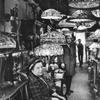Hollis Taggart Opens an Exhibition of Andy Warhol Photography at Its High Line Nine Location; An Exhibition of Jeffrey C. Becton Digital Photomontages Will Follow
- NEW YORK , New York
- /
- November 08, 2018

Hollis Taggart has opened Warhol’s Social Media at its High Line Nine location at 507 W. 27th Street, featuring more than thirty original photographs produced by Andy Warhol in the 1970s and ‘80s. The photographs, which capture celebrities as diverse as Dolly Parton, Jean-Michel Basquiat, and Truman Capote, encapsulate Warhol’s fascination with both notoriety and anonymity, and highlight his fervent commitment to documentation and artistic experimentation. This presentation of historic photographs will be followed by an exhibition of works by Jeffrey C. Becton, a pioneer in digital photography. Opening on November 28, the exhibition, Looking Out, Looking In: Jeffrey Becton, will showcase the artist’s digital photomontages, which he creates by fusing elements of photography, painting, drawing, and other techniques. Experienced in succession, the upcoming exhibitions at Hollis Taggart provide a dynamic trajectory of approach and innovation within photography and underscore the genre’s capacity to portray both reality and fiction.
Warhol’s Social Media
November 3 – 24, 2018
High Line Nine, 507 W. 27th Street
Andy Warhol’s paintings and silkscreens of celebrities, socialites, and other notables are held in many of the world’s most prominent modern art collection. However, these iconic works of larger-than-life figures often began as intimate photographs, captured with Warhol’s Polaroid Big Shot camera, which he famously referred to as his “date.” A selection of these images, drawn from one of the largest privately-held collections of the material, will go on view at Hollis Taggart this month, highlighting Warhol’s early and prescient role in the increasingly image-fueled celebrity culture.

Among the notable works in the exhibition are Dolly Parton, a 1985 Polaroid that was taken as part of a formal sitting for a silkscreen and polymer portrait made the same year; Henry Geldzahler and Jean-Michel Basquiat, a 1984 gelatin silver print that captures an intimate, impromptu moment between close friends at a party; Tina Turner, a 1981 gelatin silver print in which the singer is caught mid-gesture, beaming at the camera, before she heads onstage to open for The Rolling Stones; and Jerry Hall & Grace Jones, a 1985 gelatin silver print taken at Maria Shriver and Arnold Shwarzenegger’s wedding. Together, the photographs speak to Warhol’s innate ability with the camera, and his innovative use of perspective, distortion, distance, and intimacy to draw out his subjects at both significant and casual moments in time.
Looking Out, Looking In: Jeffery Becton
November 28 – December 15, 2018
High Line Nine, 507 W. 27th Street
Opening Reception on Wednesday, November 28, 5:00 -7:00 p.m.
Jeffery C. Becton is among the leading artists using digital technologies within photography practice. Nearly a decade prior to the advent of personal computers that employed a graphic user interface, Becton was already experimenting with early software applications for formatting type digitally at the Yale School of Art’s computer lab. This early engagement with digital tools primed him for the depth of formal and conceptual possibilities that new technologies of the 1980s would bring to artistic production.
Since 1990, Becton has worked in a genre that he refers to as digital montage, combining elements of photography with painting, drawing, and the collaging of other scanned materials. This fusion of multiple formal vocabularies gives rise to ambiguities of time, space, and location within his images, creating alternative realities that are rich with symbolism, both personal and archetypal. As a full-time resident of Maine, Becton is especially drawn to the ocean, finding meaning and inspiration in its challenging and mercurial presence—the embodiment of the beauty and harshness of life and proximity of death. Although Becton draws on his natural surroundings, the local homes, and personal imagery, his work is not about documentation but rather emotional connection—both his own to the materials he uses and the scenes that inspire him and those of the viewers, established in their engagement with his work.

The upcoming exhibition will feature a wide breadth of Becton’s work, produced between 1994 and 2018.
















